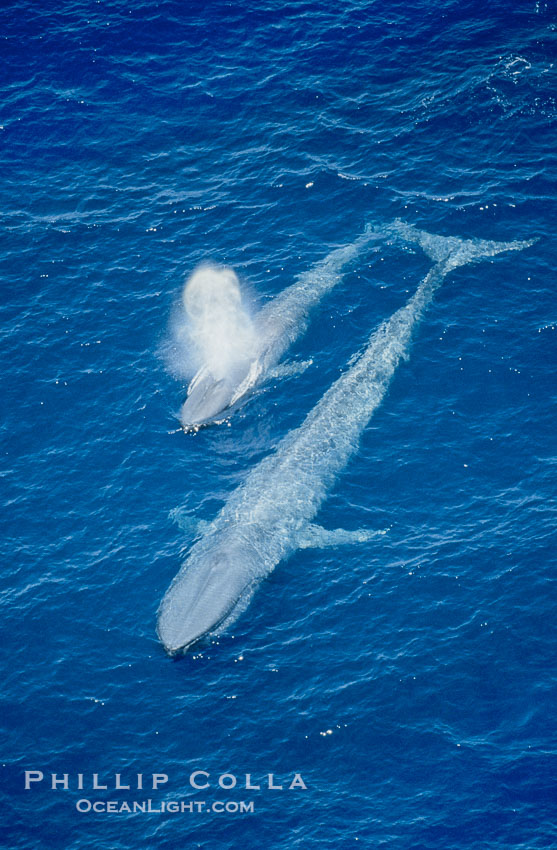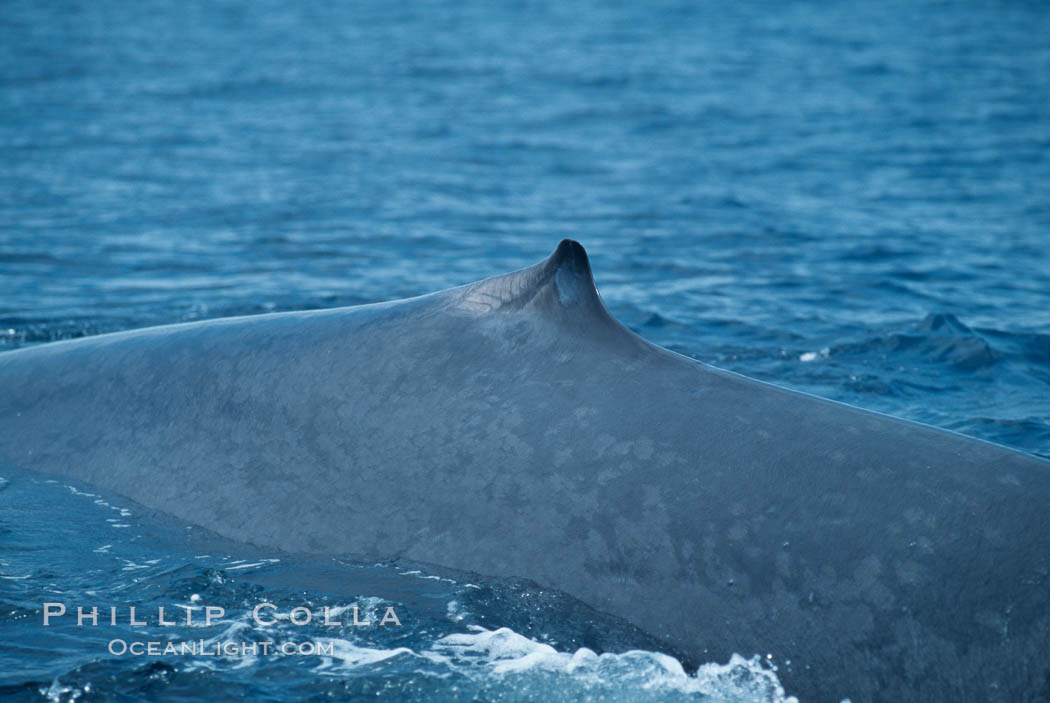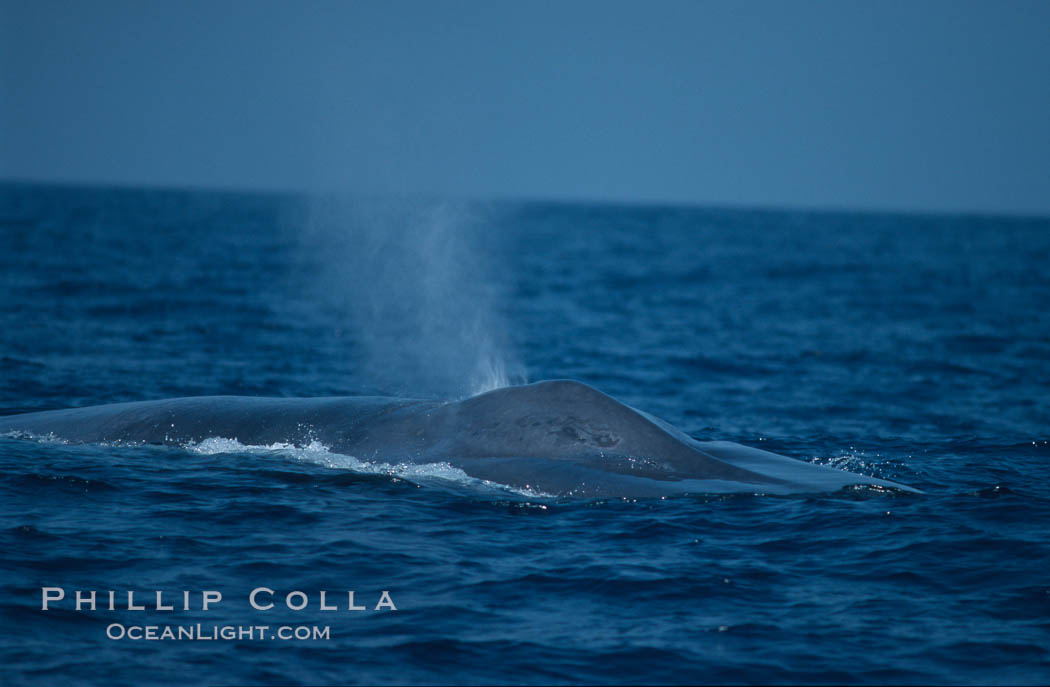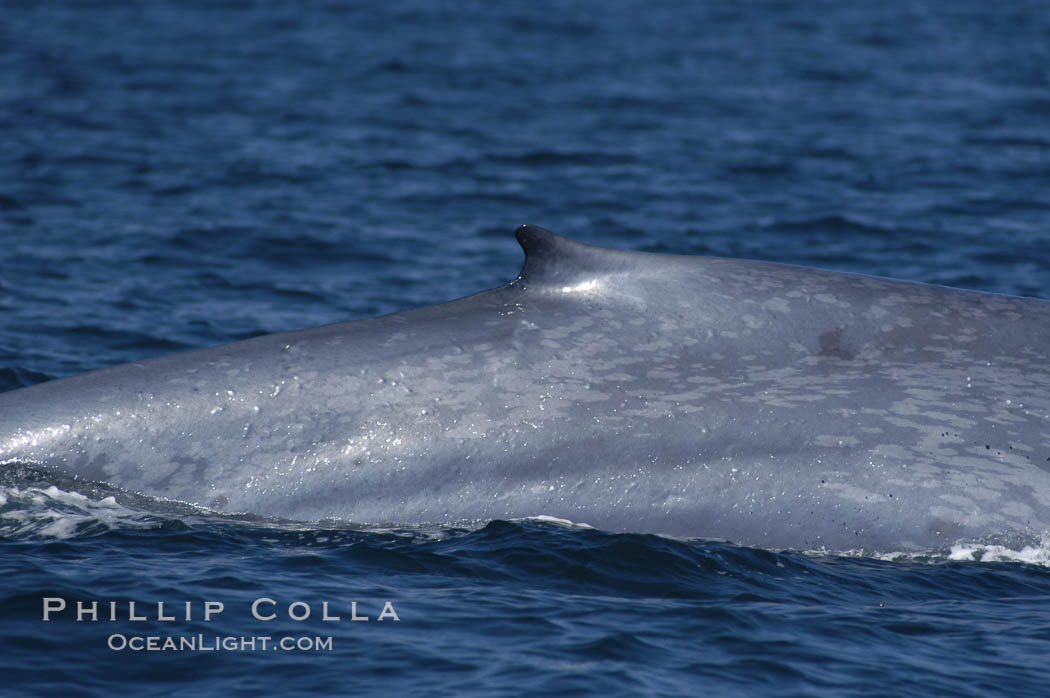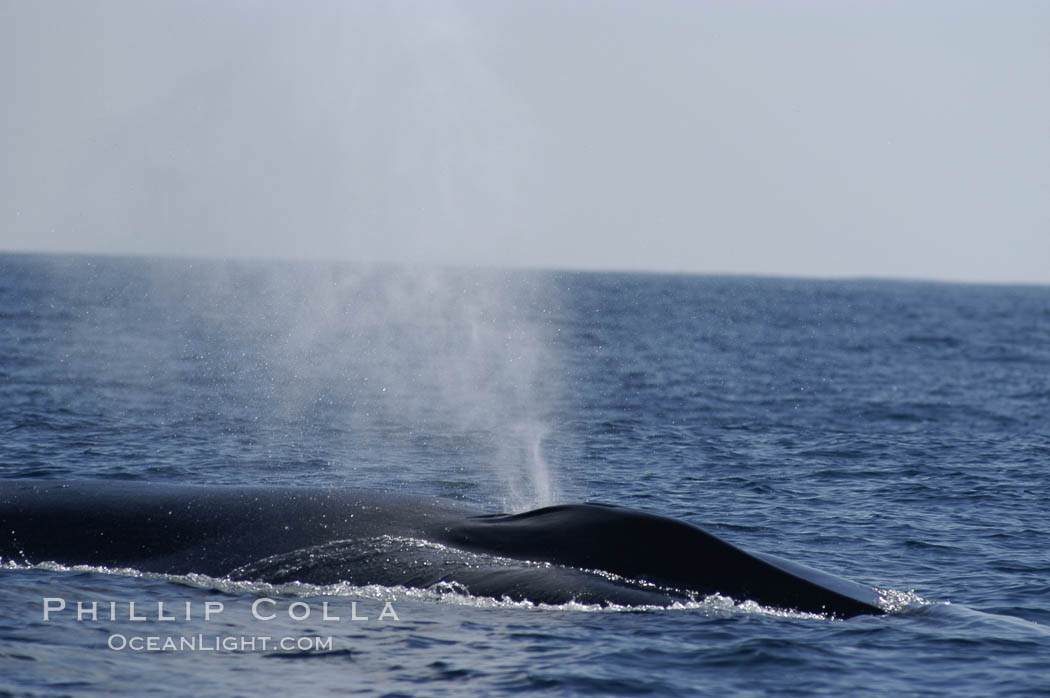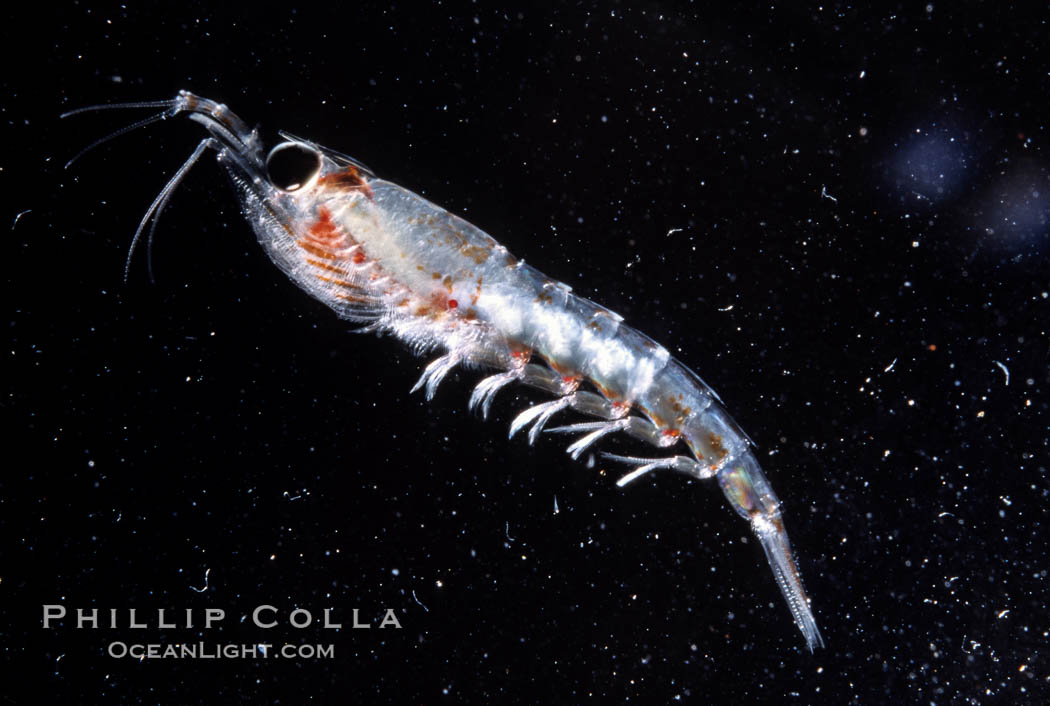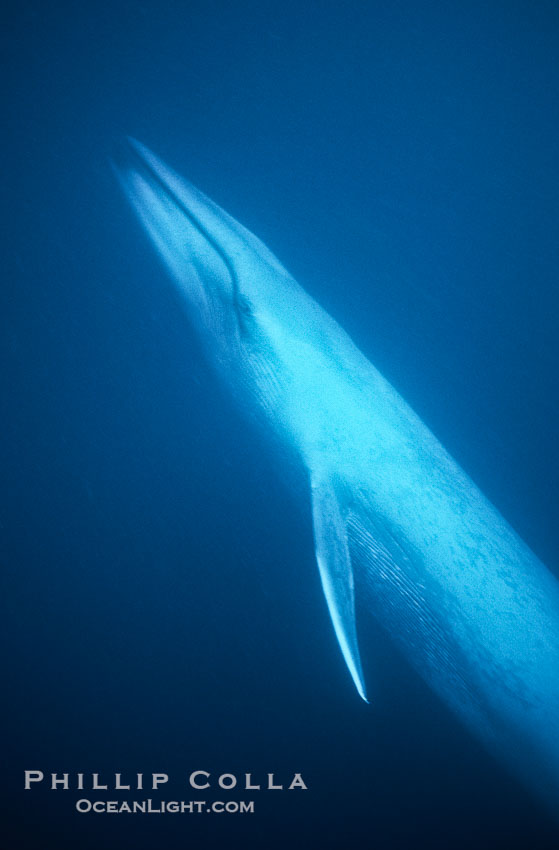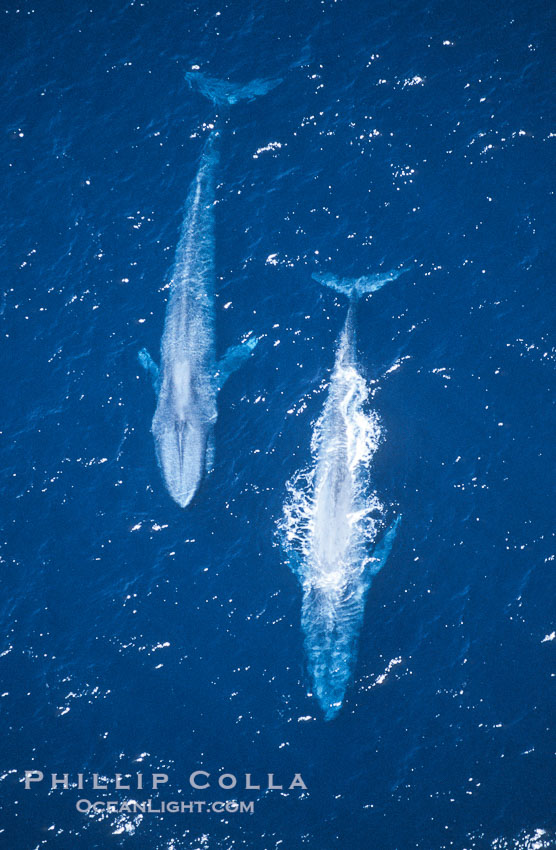The blue whale, Balaenoptera musculus, is the largest animal ever to have lived on Earth. Depending on which expert is cited, blue whales once attained lengths of 100 to 120 feet (32 meters) and have weighed up to 160 tons (145 metric tonnes). Blue whales are found throughout the worlds oceans. Estimates put their worldwide population at approximately 10% that of prewhaling size, and blue whales are listed as endangered throughout their range. The population of blue whales in the Southern Ocean was hunted especially hard.
A huge blue whale swims through the open ocean in this underwater photograph. The blue whale is the largest animal ever to live on Earth.
Image ID: 03027
Species: Blue whale, Balaenoptera musculus
Blue whale fluking up (raising its tail) before a dive to forage for krill, Baja California (Mexico).
Image ID: 03332
Species: Blue whale, Balaenoptera musculus
Blue whale, adult and juvenile (likely mother and calf), swimming together side by side underwater in the open ocean.
Image ID: 01964
Species: Blue whale, Balaenoptera musculus
Two blue whales, a mother and her calf, swim through the open ocean in this aerial photograph. The calf is blowing (spouting, exhaling) with a powerful column of spray. The blue whale is the largest animal ever to live on Earth.
Image ID: 02304
Species: Blue whale, Balaenoptera musculus
Location: San Diego, California, USA
A huge blue whale swims through the open ocean in this aerial photograph. The blue whale is the largest animal ever to live on Earth.
Image ID: 02169
Species: Blue whale, Balaenoptera musculus
Adult blue whale surfacing, Baja California (Mexico).
Image ID: 03380
Species: Blue whale, Balaenoptera musculus
Two of the images above show blue whale pairs likely composed of a mother with calf/subadult. Blue whale calves will accompany their mothers for approximately a year before being weaned. Female blue whales are larger than males, an adaptation enabling a mother to cope with the physical demands of calving and nursing.
A blue whale spouts at sunset. The blow, or spout, of a blue whale can reach 30 feet into the air. The blue whale is the largest animal ever to live on earth.
Image ID: 02217
Species: Blue whale, Balaenoptera musculus
Blue whale surfacing, Isla Coronado del Norte in background, Baja California (Mexico).
Image ID: 03342
Species: Blue whale, Balaenoptera musculus
Location: Coronado Islands (Islas Coronado), Baja California, Mexico
Adult blue whale surfacing, Baja California (Mexico).
Image ID: 03381
Species: Blue whale, Balaenoptera musculus
Blue whale, the largest animal ever to inhabit earth, swims through the open ocean, underwater view.
Image ID: 01902
Species: Blue whale, Balaenoptera musculus
Blue whale fluke, powerful tail that propels the huge whale through the open ocean.
Image ID: 01911
Species: Blue whale, Balaenoptera musculus
Blue whale, blowhole open.
Image ID: 02179
Species: Blue whale, Balaenoptera musculus
Blue whale, the largest animal ever to inhabit earth, swims through the open ocean, raising fluke (tail) before making a deep dive.
Image ID: 02226
Species: Blue whale, Balaenoptera musculus
Blue whale, lifting fluke before diving, Baja California.
Image ID: 03043
Species: Blue whale, Balaenoptera musculus
Blue whale fluking up before a dive, Baja California (Mexico).
Image ID: 03337
Species: Blue whale, Balaenoptera musculus
Blue whale, caudal stem, fluke with median notch.
Image ID: 02220
Species: Blue whale, Balaenoptera musculus
An enormous blue whale raises its fluke (tail) high out of the water before diving. Open ocean offshore of San Diego.
Image ID: 07519
Species: Blue whale, Balaenoptera musculus
Location: San Diego, California, USA
Blue whale fluke, Baja California (Mexico).
Image ID: 03339
Species: Blue whale, Balaenoptera musculus
Blue whales can swim fast, with bursts up to 20 knots. Long and streamlined, they are capable of sustaining speeds of 5 to 10 knots while traveling or foraging for food. Enormous muscles in a blue whale´s caudal flanks and peduncle power its wide flukes up and down.
Blue whale, dorsal aspect of caudal stem, Baja California (Mexico).
Image ID: 03330
Species: Blue whale, Balaenoptera musculus
Blue whale, dorsal aspect of caudal stem, Baja California (Mexico).
Image ID: 03340
Species: Blue whale, Balaenoptera musculus
Blue whale surfacing, dorsal fin, Baja California (Mexico).
Image ID: 03344
Species: Blue whale, Balaenoptera musculus
Blue whale, exhaling, note splashguard foreward of blowholes, Baja California.
Image ID: 03045
Species: Blue whale, Balaenoptera musculus
The splashguard of this approaching blue whale pushes water aside so that it can open its blowholes (which are just behind the splashguard) to breathe. Open ocean offshore of San Diego.
Image ID: 07520
Species: Blue whale, Balaenoptera musculus
Location: San Diego, California, USA
An enormous blue whale rounds out (hunches up its back) before diving. Note the distinctive mottled skin pattern and small, falcate dorsal fin. Open ocean offshore of San Diego.
Image ID: 07527
Species: Blue whale, Balaenoptera musculus
Location: San Diego, California, USA
Blue whales are most easily identified by their huge size, tall blows (up to 30 feet high), blue/gray mottled skin color, and typically rounded (falcate) dorsal fin. Skin pigment patterns along the dorsal ridge, near the dorsal fin, are photographed by scientists in order to identify individual whales. The tips of a blue whale’s fluke are rather pointed, and the trailing edge of the fluke is usually smooth and straight with a median notch. Blue whales are closely related to fin whales (Balaenoptera physalus), which are also huge, but the body of a blue whale is mottled and lighter in color and its dorsal fin is not as tall and pronounced as that of the fin whale. Also, the right lip and baleen plate of the fin whale is light colored and the underside of its body is white. (Blue and fin whales are thought to occasionally interbreed (Calambokidis)). Seen from a distance, blue whales resting or swimming just below the surface appear to be large sandbars.
An enormous blue whale swims in front of whale watchers on a private yacht. Only a small portion of the whale, which dwarfs the boat and may be 70 feet or more in length, can be seen. Open ocean offshore of San Diego.
Image ID: 07541
Species: Blue whale, Balaenoptera musculus
Location: San Diego, California, USA
An enormous blue whale is stretched out at the surface, resting, breathing and slowly swimming, during a break between feeding dives. Open ocean offshore of San Diego.
Image ID: 07534
Species: Blue whale, Balaenoptera musculus
Location: San Diego, California, USA
A blue whale blows (spouts) just as it surfaces after spending time at depth in search of food. Open ocean offshore of San Diego.
Image ID: 07544
Species: Blue whale, Balaenoptera musculus
Location: San Diego, California, USA
Pelagic red tuna crab, open ocean.
Image ID: 02247
Species: Pelagic red crab, Pleuroncodes planipes
Location: San Diego, California, USA
Pelagic red tuna crabs, Coronado Islands.
Image ID: 02353
Species: Pelagic red crab, Pleuroncodes planipes
Location: Coronado Islands (Islas Coronado), Baja California, Mexico
Krill, Baja California (Pacific Ocean).
Image ID: 03117
Species: Krill, Thysanoessa spinifera
What does a huge blue whale eat? Tons (literally) of tiny euphasiid krill, such as Thysanoessa spinifera (center). Blue whales are also known to feed on aggregations of pelagic red crabs Pleuroncodes planipes (left and right).
Blue whale, the large animal ever to live on earth, underwater view in the open ocean.
Image ID: 05814
Species: Blue whale, Balaenoptera musculus
Blue whales surfacing, Baja California (Mexico).
Image ID: 03348
Species: Blue whale, Balaenoptera musculus
Scientists estimate that the largest blue ever to have lived probably weighed more than 200 tons — 400,000 pounds — and was more massive than an entire herd of thirty African elephants. A truly impressive beast, indeed. Blue whales dwarf even the largest dinosaurs, being nearly twice the size of the largest prehistoric land dweller Brachiosaurus. A small child could crawl through the chambers of a blue whale’s immense heart, or out one of its twin blowholes. Scientific accounts cite individual blue whales nearly 100 feet in length while less reliable whaling records reported giants up to 110 feet long. The largest subspecies of blue whale, intermedia, inhabits Antarctic regions while the slightly smaller musculus is found in northern hemisphere oceans.
Blue whale dorsal flank and remora.
Image ID: 01907
Species: Blue whale, Balaenoptera musculus
Dorsal flank showing characteristic mottled skin patterns. This particular blue whale, observed in northern Mexico, also has a few dozen remora probably acquired in warmer waters to the south.
Blue whales: mother/calf pair w/ adult, Baja California (Mexico).
Image ID: 03354
Species: Blue whale, Balaenoptera musculus
Four blue whales (including calf) socializing, Baja California (Mexico).
Image ID: 03357
Species: Blue whale, Balaenoptera musculus
Blue whales: mother/calf pair w/ adult, Baja California (Mexico).
Image ID: 03369
Species: Blue whale, Balaenoptera musculus
Do blue whales socialize? Of course! But how they find one another across miles of ocean, what brings them together, and what they do when in one another´s company is still largely a mystery. Researchers around the world are gradually coming to understand the life of this greatest of whales through direct observation, remote sensing with satellite tags, and by eavesdropping on whale vocalizations with sophisticated hydrophones.
Adult blue whale surfacing, rounding out prior to dive, Baja California (Mexico).
Image ID: 03379
Species: Blue whale, Balaenoptera musculus
Blue whale.
Image ID: 01899
Species: Blue whale, Balaenoptera musculus
Blue whales: adult pair (upper left), mother/calf pair (lower right), Baja California (Mexico).
Image ID: 03351
Species: Blue whale, Balaenoptera musculus
All of the above photographs are of blue whales in the eastern North Pacific stock, a population that ranges from Baja California to at least as north as Oregon. Whales from this stock are often seen migrating north along the Pacific coast in spring and summer, typically stopping near Point Conception or the Farallon Islands to feed on aggregations of krill in August and September. For more information about blue whales, read Blue Whales by John Calambokidis and Gretchen Steiger, Voyageur Press; ISBN: 0896583384.
Keywords: blue whale, photo, underwater, picture, Balaenoptera musculus, aeria



